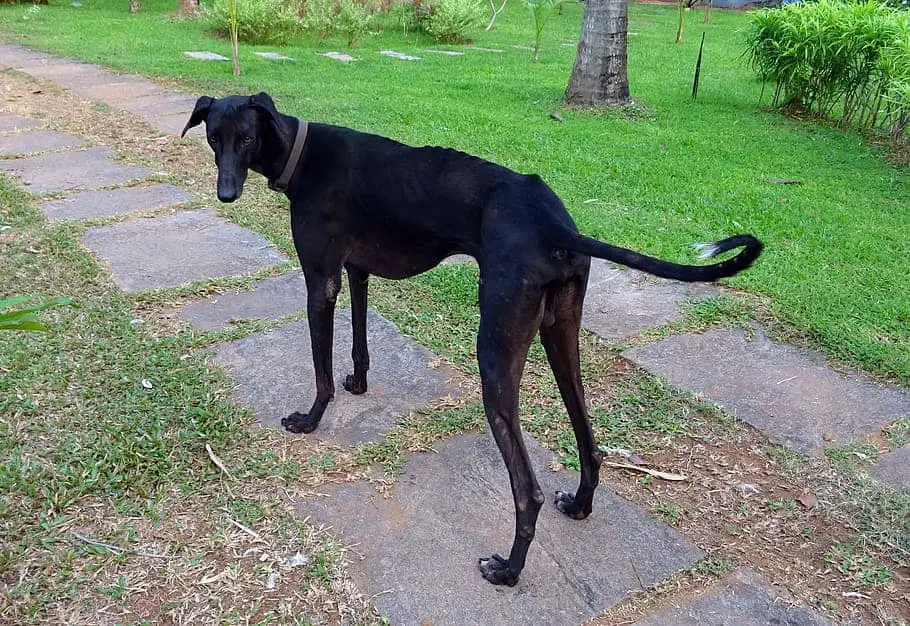Limber tail syndrome is also known as swimmer’s tail or broken tail. It is a condition that affects a dog’s tail, causing it to appear limp and lifeless. It causes the tail muscles to become inflamed and weak. This can make it difficult for the dog to wag its tail and cause pain when it is touched. A limber tail is usually caused by overexertion, especially in cold weather. It usually heals on its own within 3-5 days.
Key Takeaways of Swimmers Tail Dog
- Swimmer’s tail syndrome is a medical condition affecting many dogs, especially large breeds and hunting dogs.
- Overuse of the tail muscles, swimming, cold or wet weather exposure, confinement, and hypothyroidism have all been linked to causing limber tail syndrome in dogs.
- Symptoms include a limp or drooping tail, reduced wagging or no wagging at all, raised fur on the top of the tail, whimpering or whining when the base of the tail is touched, reluctance to sit due to discomfort in the tail area and difficulty defecating.
- Prevention strategies involve conditioning programs for your dog’s regular exercise routine and gradual exposure to exercise with limited time spent in water.

limber tail causes
Overuse, swimming, cold or wet weather exposure, confinement, and hypothyroidism have all been linked to causing broken wag syndrome in dogs.
Swimming
Swimming is a notable risk factor for developing limber tail syndrome in dogs. Particularly within 24 hours of engaging in strenuous water-based activities. This could be attributed to our four-legged companions using their tails extensively while swimming, helping them change direction in the water.
Pet owners need to monitor their dog’s behavior closely after they’ve spent time swimming. Anecdotes from hunters provide numerous accounts of seemingly healthy pups suddenly afflicted by limber tails after a day of heavy hunting involving exposure to cold waters.

Vigorous Exercise
Vigorous exercise is a major factor in developing limber tail syndrome, especially among large breed dogs such as Labrador Retrievers and English Pointers.
These athletic canines are known for their energetic nature and often engage in activities that require powerful tail wagging, like sprinting or jumping. For example, hunting dogs who cover vast distances over rough terrain with speed and agility may be more prone to developing this painful condition.
Cold Or Wet Weather
Cold or wet weather can significantly increase the risk of limber tail syndrome in dogs. Prolonged exposure to such conditions, particularly with strenuous activities like swimming and hunting, can lead to this painful condition.
For example, a Labrador retriever who spends hours playing fetch in chilly rain or cold water may experience the onset of swimmer’s tail syndrome due to muscle strain and fatigue. Similarly, wet weather might make it difficult for tails to dry off completely after prolonged outdoor activity.
Confinement
Confinement in a cage or kennel for long periods is one of the risk factors for limber tail syndrome in dogs. It can cause physical and mental stress, leading to muscle damage and weakness that may result in a limp tail.
Hunting dogs and those who undergo training sessions are particularly susceptible to this condition due to confinement during transport. Even though confinement alone may not always lead to broken tail, it increases the chances when combined with other risk factors such as vigorous exercise or exposure to cold weather.
Hypothyroidism
Hypothyroidism is a medical condition that can cause hair loss on the tail, leading to a “rat tail” appearance in dogs. In some cases, this condition has been reported to be comorbid with limber tail syndrome.
Hypothyroidism occurs when the thyroid gland does not produce enough hormones for proper metabolism and energy use. If left untreated, this can lead to weight gain, lethargy, and other health issues. A thorough examination by a veterinarian may include testing for hypothyroidism, assessing muscle damage, and ruling out other diseases.

limber tail symptoms
Some signs of cold tail include:
- A limp tail that may droop limply between the dog’s rear legs or stick straight out before drooping
- No tail wagging or reduced tail wagging
- Raised fur on the top of the tail
- Whimpering or whining when the tail is touched or moved
- Reluctance to sit due to discomfort in the tail area
- Difficulty defecating and loss of appetite
- Pain at the base of the tail
- Swelling at the base of the tail
- Lethargy and decreased interest in activities
How Is A Broken Tail Diagnosed?
Diagnosis of limber tail syndrome involves a thorough physical examination by a veterinarian to evaluate the dog’s tail’s condition. In most cases, vets can diagnose it without additional testing, but X-rays may be used to rule out other possible causes.
The vet will typically ask whether your dog has engaged in any recent high activity or swimming that could have caused muscle damage in the dog’s tail. As soon as you notice symptoms such as limping tail, difficulty wagging the tail, and whimpering when touched around the tail base, contact the vet.
Cold Tail Syndrome is easily confused with anal gland problems and intervertebral disc disease (IVDD).
how to prevent swimmer’s tail in dogs?
Proper care and attention must be given to prevent broken wag in dogs. Here are some effective prevention techniques that can help:
- Conditioning: Appropriate dog conditioning programs can be planned to prevent limber tail. Dogs should have regular exercise, but over-exercise should be avoided.
- Gradual Exposure: Gradual exposure to exercise and building endurance slowly are effective prevention techniques
- Limit time spent in water: Dogs’ time spent in the water should be limited as a prevention measure
- Build up strength: Maintaining good physical condition is important to prevent limber tail in dogs. Strength-building exercises should be incorporated into the dog’s routine.
- Keep them warm: During cold or wet weather, provide your dog with adequate protection from the elements by keeping them warm.

limber tail syndrome treatment
The treatment for broken tail syndrome may include rest, pain medication, and anti-inflammatory medication; however, the prognosis is generally good as most dogs recover fully within a few days to a few weeks.
limber tail treatment at home
Anti-inflammatory pain medications such as meloxicam (Metacam), carprofen (Rimadyl), and firocoxib (Previcox) can be prescribed by veterinarians to reduce swelling, relieve pain, and promote faster healing.
These medications work by inhibiting the inflammation that causes discomfort and muscle damage in the tail. The limber tail syndrome usually resolves independently within a few days to a week, even without medication. However, giving medication can help reduce the dog’s discomfort and speed up recovery.
General Cost for Fixing Flaccid tail
Treating limber tail syndrome in dogs typically costs between $50 to $150, depending on the size of your pooch and the veterinarian you visit. While this may seem like a significant expense, remember that most cases of limber tail resolve independently within 3-5 days without any treatment.
If your furry friend is experiencing discomfort or pain from the limber tail, over-the-counter anti-inflammatory medication can help alleviate some symptoms.
Is Broken Wag A True Medical Condition?
Limber tail syndrome or acute caudal myopathy is a true medical condition affecting many dogs, especially large breeds and hunting dogs like the Labrador Retriever and English Pointer. To diagnose limber tail syndrome accurately, a thorough examination by your veterinarian may include X-rays to rule out any underlying health issues like intervertebral disc disease or cancer of the tail.
What Else Can Explain These Cold Tail Symptoms?
Tail injuries are not always the cause of the limber tail syndrome. Several other possibilities can explain these symptoms, including infections or inflammation around the tail area and lower back problems such as intervertebral disc disease, arthritis, or other spinal cord issues.
Taking your dog to a veterinarian for a thorough examination. A proper diagnosis is crucial because treatment varies depending on the underlying cause. In most cases, anti-inflammatory medication coupled with rest is enough to reduce swelling.
Not all limp tails result from the overuse of muscles. Seek veterinary assistance early to have the limber tail diagnosed on if you observe any symptoms

Advice From Veterinary Professionals
This condition is relatively common in hunting breeds like retrievers and spaniels but can occur in any breed. Veterinary professionals have been asked numerous questions about limber tail syndrome.
One of the most frequently asked questions is whether cold water causes limber tail syndrome. While swimming may contribute to the development of the condition, it does not necessarily cause it.
Another question that veterinary professionals receive about limber tail syndrome concerns prevention methods for the condition. Preventing this painful condition requires moderation and awareness of your dog’s activity levels. Finally, many pet owners wonder if some other diseases or conditions exhibit similar symptoms as those seen in dogs with limber tail syndrome.
FAQ on limber tail treatment
is limber tail painful?
Yes, the dog swimmers tail is painful for dogs. Acute Caudal Myopathy is a condition that causes the muscles in the tail to become inflamed and weak. This can make it difficult for the dog to wag its tail and cause pain when it is touched.
How serious is limber tail in dogs?
The limber tail is not usually serious and heals within a few days. However, it can be uncomfortable for the dog, so it is important to provide them with plenty of rest and pain relief.
how long does limber tail last?
Yes, limber tail usually heals within 3-5 days. However, providing your dog with plenty of rest and pain relief during this time is important. Gabapentin for limber tail works well
Should you walk dog with limber tail?
You should not walk a dog with limber tail. The exercise will only make the condition worse. Instead, you should keep your dog calm and quiet for a few days until the tail has healed.
Is gabapentin for limber tail good?
Yes, gabapentin is a good medication for limber tail. It is a safe and effective way to reduce pain and inflammation in the tail. It can also help calm the dog down, making it easier for them to rest.
Does a dog’s broken tail heal on its own?
Yes, a dog’s broken tail can heal on its own. However, the tail may take several weeks or even months to fully heal. The best way to help your dog’s tail heal is to keep it clean and protected. You can do this by wrapping the tail in a bandage or using a cone to prevent your dog from licking it. You should also avoid letting your dog swim or play too rough until the tail is healed.
If your dog’s tail is severely broken, your veterinarian may recommend surgery to repair it. However, surgery is not always necessary and should only be considered in cases where the tail is badly damaged.
Author Profile
- Site Owner And Planning Specialist
-
Aritra, the founder of Labradorandyou.com, is a lifelong dog lover whose passion ignited for Labradors for their loyalty and intelligence. With extensive research and personal experiences, Aritra has become a Labrador expert, offering a rich resource on the breed. Labradorandyou.com provides reliable, timely, and evidence-based information, including Labrador-specific product reviews, training techniques, and care tips.
Labradorandyou.com was born out of Aritra's passion and his desire to share his profound knowledge about the breed. The site serves as a comprehensive resource, offering a wealth of up-to-date information for Labrador owners and enthusiasts alike
Also by the author
 FAQNovember 17, 2023How To Adopt An Emotional Support Dog?
FAQNovember 17, 2023How To Adopt An Emotional Support Dog? Mix-BreedsNovember 16, 2023Red Labradoodle Ultimate Guide: Breed Facts, Care Tips
Mix-BreedsNovember 16, 2023Red Labradoodle Ultimate Guide: Breed Facts, Care Tips Top BreedersNovember 8, 2023Breeding Labradors: Everything You Need to Know
Top BreedersNovember 8, 2023Breeding Labradors: Everything You Need to Know FAQOctober 17, 2023Do Dogs Like Music? Researchers Say Yes! Find Out
FAQOctober 17, 2023Do Dogs Like Music? Researchers Say Yes! Find Out





